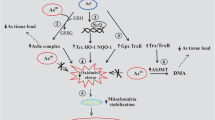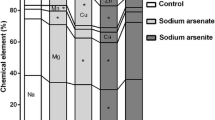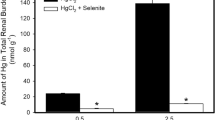Abstract
The long-term toxicity of arsenic (As) as a result of exposure to contaminated drinking water might be modified by coinciding exposures to elements like selenium, antimony, or mercury. In this study the influence of tetravalent selenite, trivalent antimonite, and divalent mercury was investigated in vitro using cultured primary rat hepatocytes. The cell vitalty was assessed in the 3-[4,5-dimethylthiazol-2-yl-2,5-diphenyltetra-zolium bromide] (MTT), assay with concurrent exposures of the cells to up to 50 μM sodium arsenite(III) and a potential modifier [50 μM sodium(IV) selenite, 10 μM antimony(III) chloride, 25 μM mercuric(II) chloride], which indicated an additive increase in the combined cytotoxicity. Sodium arsenite was tested for genotoxicity in the micronucleus test in a concentration range of 0.25 up to 7.5 μM. In this range, the MTT conversion was at least 80%, indicating high cell viability. A dose-dependent induction of micronuclei was observed. The lowest concentration causing a significantly elevated frequency of micronuclei was 1 μM As (p<0.05). A significant influence (i.e., reduction of the combined genotoxicity as a result of the presence of a potential modifier) was only observed for 10 and 25 μM antimony chloride (p<0.05, Fisher's exact test). The metabolic methylation of arsenite was not affected by concurrent incubation with any of the potential modifiers.
Similar content being viewed by others
References
A. H. Smith, E. O. Lingas, and M. Rahman, Contamination of drinking-water by arsenic in Bangladesh: a public health emergency, Bull. WHO 78, 1093–1103 (2000).
A. Basu, P. Ghosh, J. K. Das, A. Banerjee, K. Ray, and A. K. Giri. Micronuclei as biomarkers of carcinogen exposure in populations exposed to arsenic through drinking water in West Bengal, India: a comparative study in three cell types, Cancer Epidemiol. Biomarkers Prev. 13(5), 820–827 (2004).
V. Mart Chilean population environmentally exposed to arsenic, Mutat. Res. 564, 65–75 (2004).
V. Mart environmentally exposed to arsenic in Northern Chile, Toxicol. Lett. 155, 319–327 (2005).
J. Mahata, A. Basu, S. Ghoshal, et al., Chromosomal aberrations and sister chromatid exchanges in individuals exposed to arsenic through drinking water in West Bengal, India, Mutat. Res. 534, 133–143 (2003).
T. W. Gebel, Arsenic and drinking water contamination, Science 283, 1458–1459 (1999).
R. R. Engel, C. Hopenhayn-Rich, O. Receveur, and A. H. Smith, Vascular effects of chronic arsenic exposure: a review, Epidemiol. Rev. 16, 184–209 (1994).
J. L. Valentine, M. E. Cebrian, G. G. Garcia-Vargas, et al., Daily selenium intake estimates for residents of arsenic-endemic areas, Environ. Res. 64, 1–9 (1994).
T. Gebel, Confounding variables in the environmental toxicology of arsenic, Toxicology 144, 155–162 (2000).
L. Beckman and I. Nordenson, Interaction between some common genotoxic agents, Mum. Hered. 36, 397–401 (1986).
T. Gebel, Suppression of arsenic-induced chromosome mutagenicity by antimony, Mutat. Res. 412, 213–218 (1998).
T. Gebel, S. Christensen, and H. Dunkelberg, Comparative and environmental genotoxicity of antimony and arsenic, Anticancer Res 17, 2603–2607 (1997).
D. J. Thomas, M. Styblo, and S. Lin, The cellular metabolism and systemic toxicity of arsenic, Toxicol. Appl. Pharm. 176, 127–144 (2001).
D. J. Thomas, S. B. Waters, and M. Styblo, Elucidating the pathway for arsenic methylation, Toxicol. Appl. Pharmacol. 198, 319–326 (2004).
H. Vasken Aposhian, R. A. Zakharyan, M. D. Avram, A. Sampayo-Reyes, and M. L. Wollenberg, A review of the enzymology of arsenic metabolism and a new potential role of hydrogen peroxide in the detoxication of the trivalent arsenic species, Toxicol. Appl. Pharmacol. 198, 327–335 (2004).
M. Styblo, L. M. Del Razo, L. Vega, et al., Comparative toxicity of trivalent and pentavalent inorganic and methylated arsenicals in rat and human cells, Arch. Toxicol. 74, 289–299 (2000).
M. J. Mass, A. Tennant, B. C. Roop, et al., Methylated trivalent arsenic species are genotoxic, Chem. Res. Toxicol. 14, 355–361 (2001).
A. D. Kligerman, C. L. Doerr, A. H. Tennant, et al., Methylated trivalent arsenicals as candidate ultimate genotoxic forms of arsenic: induction of chromosomal mutations but not gene mutations, Environ. Mol. Mutagen 42, 192–205 (2003).
K. Kuroda, K. Yoshida, M. Yoshimura, et al., Genotoxicity of dimethylarsinous acid: high induction of tetraploids, Appl. Organometal. Chem. 19, 221–225 (2005).
K. Mure, A. N. Uddin, L. C. Lopez, M. Styblo, and T. G. Rossman, Arsenite induces delayed mutagenesis and transformation in human osteosarcoma cells at extremely low concentrations, Environ. Mol. Mutagen. 41, 322–331 (2003).
T. W. Gebel, Arsenic methylation is a process of detoxification through accelerated excretion, Int. J. Hyg. Environ. Health 205, 505–508 (2002).
J. De Kimpe, R. Cornelis, and R. Vanholder, In vitro methylation of arsenite by rabbit liver cytosol: effect of metal ions, metal chelating agents, methyltransferase inhibitors and uremic toxins, Drug Chem. Toxicol. 22, 613–628 (1999).
M. Styblo, M. Delnomdedieu, and D. J. Thomas, Mono-and dimethylation of arsenic in rat liver cytosol in vitro, Chem.-Biol. Interact. 99, 647–164 (1996).
L. L. Hall, S. E. George, M. J. Kohan, M. Styblo, and D. J. Thomas, In vitro methylation of inorganic arsenic in mouse intestinal cecum, Toxicol. Appl. Pharmacol. 147, 101–109 (1997).
E. M. Kenyon, M. F. Hughes, and O. A. Levander, Influence of dietary selenium on the disposition of arsenate in the female B6C3F1 mouse, J. Toxicol. Environ. Health 51, 279–299 (1997).
R. Bailly, R. Lauwerys, J. P. Buchet, P. Mahieu, and J. Konings, Experimental and human studies on antimony metabolism: their relevance for the biological monitoring of workers exposed to inorganic antimony, Br. J. Ind. Med. 48, 93–97 (1991).
N. Schaumlöffel and T. Gebel, Heterogeneity of the DNA damage provoked by antimony and arsenic, Mutagenesis 13, 281–286 (1998).
T. W. Gebel, R. H. H. Suchenwirth, C. Bolten, and H. Dunkelberg, Human biomonitoring of arsenic and antimony in case of an elevated geogenic exposure, Environ. Health Perspect. 106, 33–39 (1998).
T. Gebel, C. Behmke, and H. Dunkelberg, Einfluß einer geogenen Exposition von Quecksilber, Arsen und Antimon auf die Körperbelastung—eine Biomonitoring-Studie, Zentralbl. Hyg. Umweltmed. 201, 103–120 (1998).
P. O. Seglen, Preparation of isolated rat liver cells, Methods Cell. Biol. 13, 29–83 (1976).
P. M. Eckl and I. Raffelsberger, The primary rat hepatocyte micronucleus assay: general features, Mutat. Res. 392, 117–124 (1997).
K. Müller-Tegethoff, B. Kersten, P. Kasper, and L. Müller, Application of the in vitro rat hepatocyte micronucleus assay in genetic toxicology testing, Mutat. Res. 392, 125–138 (1997).
M. Fenech, The cytokinesis-block technique: a detailed description of the method and its application to genotoxicity studies in human populations, Mutat. Res. 285, 35–44 (1993).
M. Fenech, The advantages and disadvantages of the cytokinesis-block micronucleus method, Mutat. Res. 397, 11–18 (1997).
M. Kirsch-Volders, T. Sofuni, M. Aardema, et al., Report from the in vitro micronucleus assay working group, Environ. Mol. Mutagen 35, 167–172 (2000).
J. Feldmann, V. W. Lai, W. R. Cullen, M. Ma, X. Lu, and X. C. Le, Sample preparation and storage can change arsenic speciation in human urine, Clin. Chem. 45, 1988–1997 (1999).
Z. Gregus, A. Gyurasics, and I. Csanaky, Biliary and urinary excretion of inorganic arsenic: monomethylarsonous acid as a major biliary metabolite in rats, ToxicolScci. 56, 18–25 (2000).
S. Biswas, G. Talukder, and A. Sharma, Prevention of cytotoxic effects of arsenic by short-term dietary supplementation with selenium in mice in vivo, Mutat. Res. 441, 155–160 (1999).
K. T. Kitchin, Recent advances in arsenic carcinogenesis: modes of action, animal model systems, and methylated arsenic metabolites, Toxicol. Appl. Pharmacol. 172, 249–261 (2001).
J. P. Buchet and R. Lauwerys, Study of inorganic arsenic methylation by rat liver in vitro: relevance for the interpretation of observations in man, Arch. Toxicol. 57, 125–129 (1985).
M. Styblo and D. J. Thomas, Selenium modifies the metabolism and toxicity of arsenic in primary rat hepatocytes, Toxicol. Appl. Pharmacol. 172, 52–61 (2001).
F. S. Walton, S. B. Waters, S. L. Jolley, E. L. LeCluyse, D. J. Thomas, and M. Styblo, Selenium compounds modulate the activity of recombinant rat As-III-methyltransferase and the methylation of arsenite by rat and human hepatocytes, Chem. Res. Toxicol. 16, 261–265 (2003).
I. Csanaky and Z. Gregus, Effect of phosphate transporter and methylation inhibitor drugs on the disposition of arsenate and arsenite in rats, Toxicol. Sci. 63, 29–36 (2001).
Author information
Authors and Affiliations
Rights and permissions
About this article
Cite this article
Hasgekar, N., Beck, J.P., Dunkelberg, H. et al. Influence of antimonite, selenite, and mercury on the toxicity of arsenite in primary rat hepatocytes. Biol Trace Elem Res 111, 167–183 (2006). https://doi.org/10.1385/BTER:111:1:167
Received:
Revised:
Accepted:
Issue Date:
DOI: https://doi.org/10.1385/BTER:111:1:167




